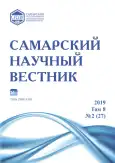The results of the Fatyanovo-Balanovo and the late Volosovo population contacts in pottery traditions
- Authors: Volkova E.V.1
-
Affiliations:
- Institute of Archeology of Russian Academy of Sciences
- Issue: Vol 8, No 2 (2019)
- Pages: 129-136
- Section: 07.00.00 – Historical Sciences and Archaeology
- URL: https://journals.rcsi.science/2309-4370/article/view/34311
- DOI: https://doi.org/10.17816/snv201982207
- ID: 34311
Cite item
Full Text
Abstract
Due to the Historical-and-Cultural approach to ancient ceramics studies the development of mixed pottery traditions reflects the amalgamation of the very bearers of these traditions. Taken as a problem, the study of populations’ contacts with different levels of pottery production is specific for a wide variety of territories and chronological periods. In the Upper and Middle Volga region the problem manifests itself in appearance of the mixed pottery traditions (morphological as well as technological ones) as a result of contacts between the Fatyanovo-Balanovo population and the late Volosovo population. So-called «Fatyanoid» (or «Fatyanovo-like») pottery that demonstrates features of the Volosovo and the Fatyanovo-Balanovo cultural traditions emerges in the process of amalgamation. A.A. Spitsyn, M.E. Foss, N.N. Gurina, I.V. Gavrilova, O.S. Gadzyatskaya and other researchers paid their attention to the problem. Based on the study of pottery collected at a number of archeological monuments including pottery from unfortified settlements - Nikolo-Perevoz I and II, Sakhtysh I, II, IV, Dikarikha, Iberdus I, Lipovka I and Galankina Gora - the author distinguishes three groups of the Fatyanoid (Fatyanovo-like) pottery: group I includes pottery with mixed Fatyanovo and Oshpandino traditions, group II includes pottery with mixed Fatyanovo and late Volosovo traditions, and group III includes pottery with the Fatyanovo traditions mixed with traditions of the population that consisted of bearers of the Bronze Age culture which is hard to define. These groups are present nearly at all archeological monuments though Fatyanovo-like pottery predominates at every monument. The author distinguishes pottery traditions common to the second group and explains the reason of their differences found at different monuments.
Keywords
Full Text
##article.viewOnOriginalSite##About the authors
Elena Vitalievna Volkova
Institute of Archeology of Russian Academy of Sciences
Author for correspondence.
Email: volk_h@mail.ru
candidate of historical sciences, senior researcher of Theory and Methods Department
Russian Federation, MoscowReferences
- Волкова Е.В. Гончарство фатьяновских племен. М.: Наука, 1996. 122 с.
- Эпоха бронзы лесной полосы СССР // Археология СССР / под ред. Б.А. Рыбакова. М.: Наука, 1987. С. 10-34.
- Раушенбах В.М. Фатьяновское погребение на неолитической стоянке Николо-Перевоз // Тр. ГИМ. Вып. 37. М.: Советская Россия, 1960. С. 28-37.
- Фосс М.Е. Древнейшая история севера Европейской части СССР // Материалы и исследования по археологии СССР. № 29. М.: АН СССР, 1952. С. 153-193.
- Бобринский А.А. Гончарство Восточной Европы. Источники и методы изучения. М.: Наука, 1978. 272 с.
- Цетлин Ю.Б. Древняя керамика. Теория и методы историко-культурного подхода. М.: ИА РАН. 384 с.
- Крайнов Д.С. Древнейшая история Волго-Окского междуречья. Фатьяновская культура. М.: Наука, 1972. 274 с.
- Гурина Н.Н. Памятники эпохи бронзы и раннего железа в Костромском Поволжье (по материалам Горьковской экспедиции) // Материалы и исследования по археологии СССР. № 110. М.-Л.: АН СССР, 1963. С. 85-203.
- Попова Т.Б. Допоздняковские памятники в Окском бассейне // Экспедиции ГИМ. М.: ГИМ, 1969. С. 64-73.
- Гаврилова И.В. Фатьяноидная керамика Костромского Поволжья // Изыскания по мезолиту и неолиту СССР. Л.: Наука, 1983. С. 101-109.
- Гадзяцкая О.С. Фатьяновский компонент в культуре поздней бронзы (Волго-Камское междуречье) // СА. 1992. № 1. С. 122-141.
- Сидоров В.В. Желобчатые венчики // Верхнедонской археологический сборник. Липецк: РИЦ ФГБОУ ВПО «ЛГПУ», 2014. Вып. 6. С. 218-227.
- Волкова Е.В. Новинковские могильники фатьяновской культуры. М.: ИА РАН, 2010. 248 с.
- Волкова Е.В. Бинокулярный анализ керамики бронзового века лесной зоны Восточной Европы (к обсуждению термина «фатьяноидная» керамика) // Археология, этнография и антропология Евразии. 2018. Т. 46, № 2. С. 52-59.
- Волкова Е.В. Культурный состав населения и относительная периодизация жилищ поселения Галанкина Гора (по данным изучения керамики) // Краткие сообщения Института археологии. 2018. Вып. 249. Ч. 1. С. 153-166.
- Волкова Е.В. Об относительной устойчивости орнаментальных традиций в гончарстве (по материалам эпохи бронзы) // Краткие сообщения Института археологии. 2018. Вып. 251. С. 96-109.
- Раушенбах В.М. Стоянка Николо-Перевоз II на р. Дубне в Московской области // Экспедиции ГИМ. М.: ГИМ, 1969. С. 80-93.
- Соловьев Б.С. Бронзовый век Марийского Поволжья // Труды марийской археол. экспедиции. Т. VI. Йошкар-Ола: МарНИИЯЛИ, 2000. С. 13-228.
- Халиков А.Х. Древняя история Среднего Поволжья. М.: Наука, 1969. 395 с.
- Соловьев Б.С. К вопросу о финале волосовской культуры на Средней Волге // Вопросы археологии камня и бронзы в Среднем Поволжье и Волго-Камье // Археология и этнография Марийского края. Вып. 31. Йошкар-Ола: МарНИИЯЛИ, 2015. С. 165-175.
Supplementary files









